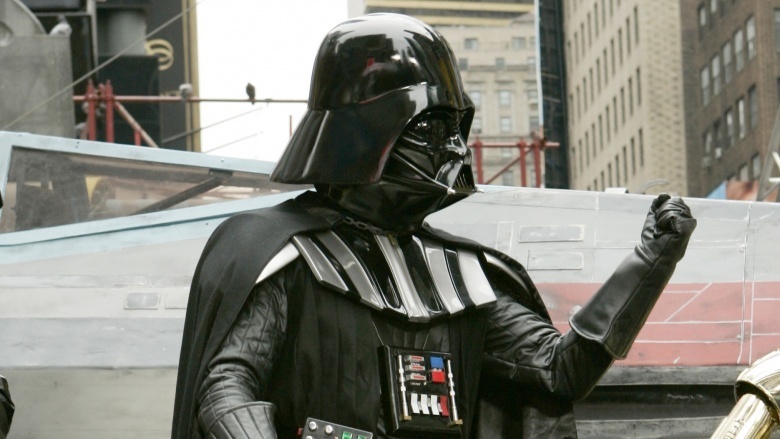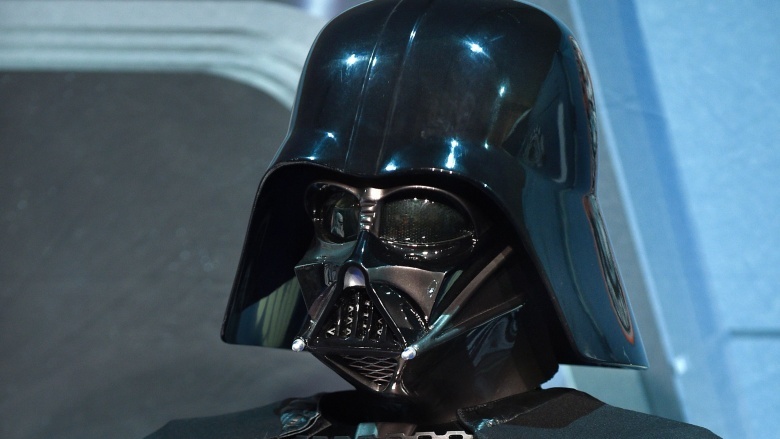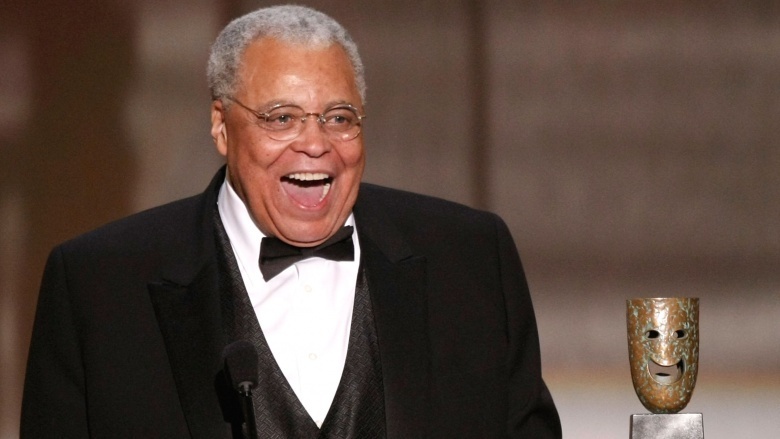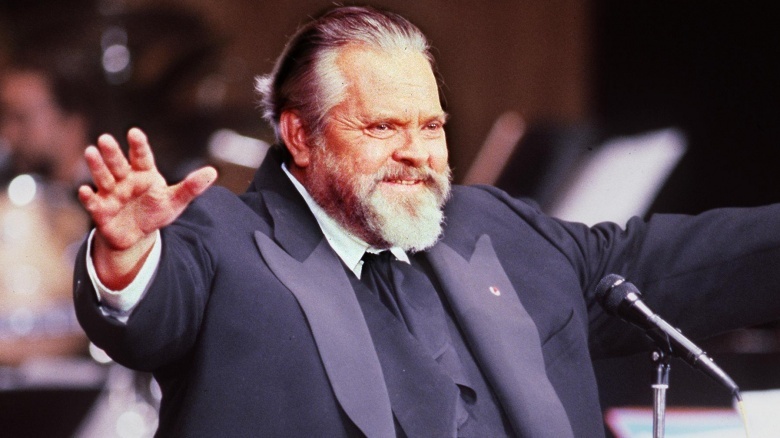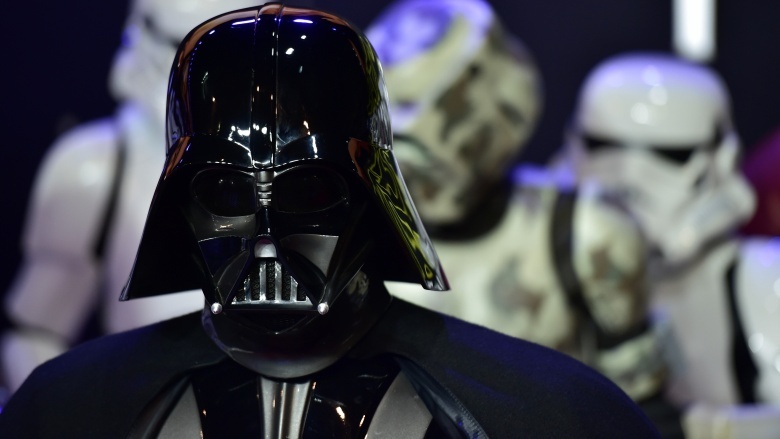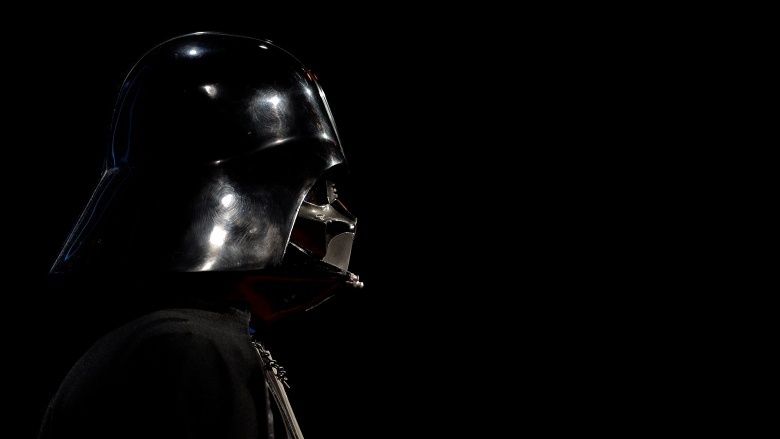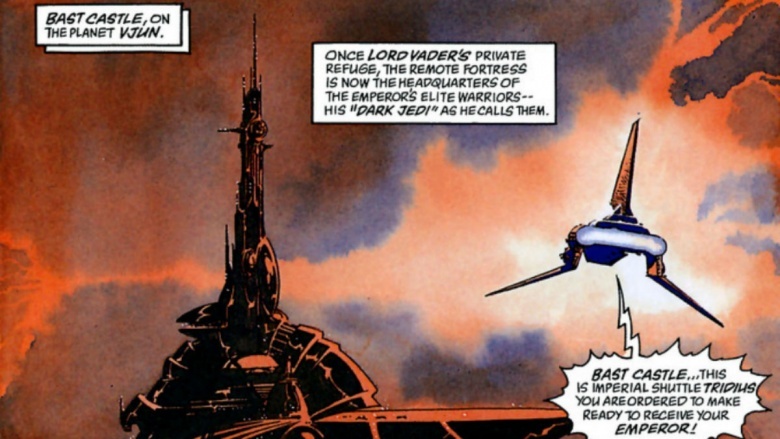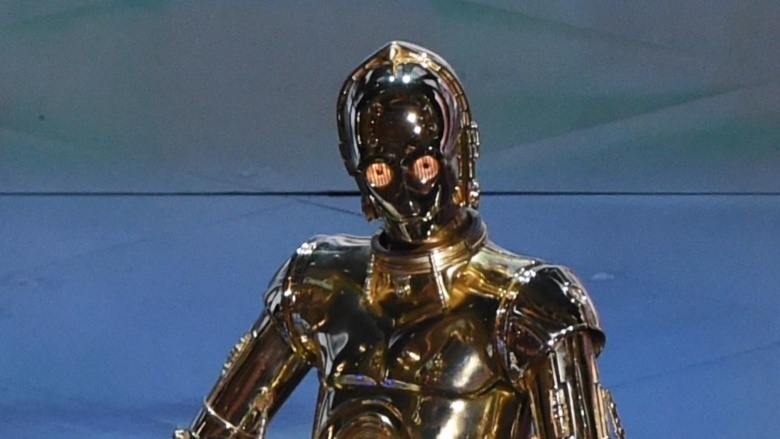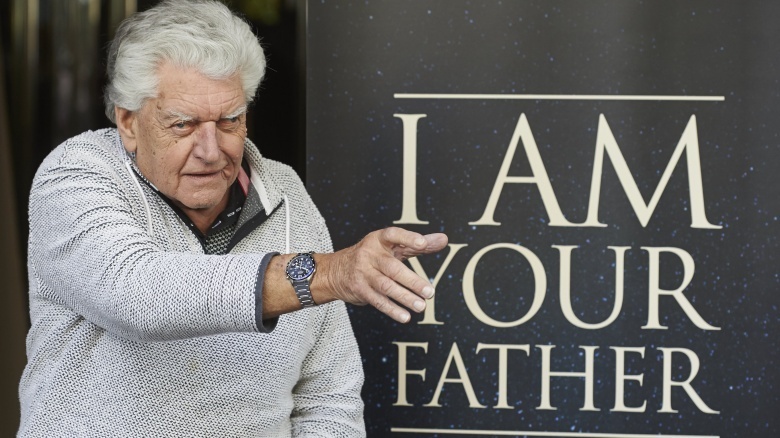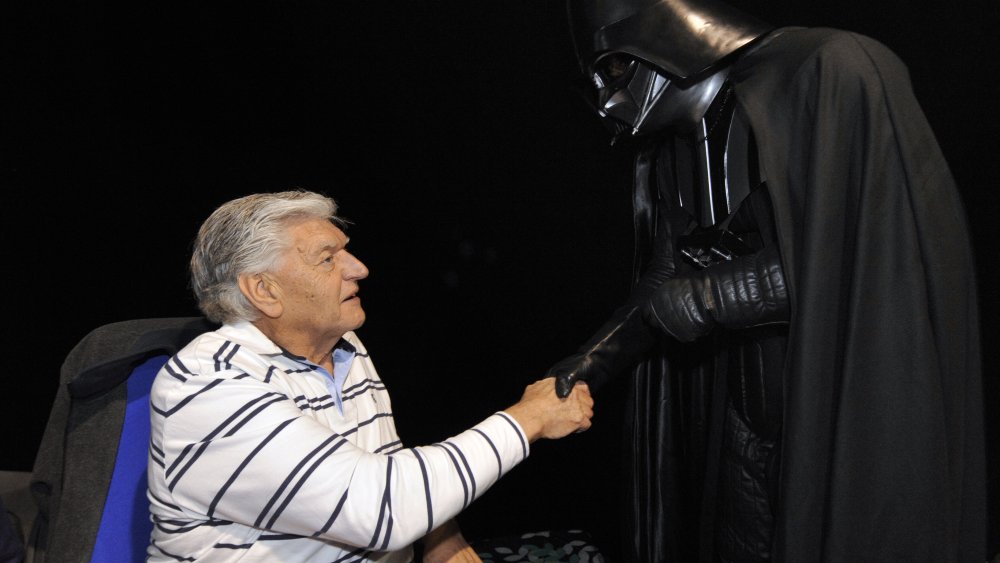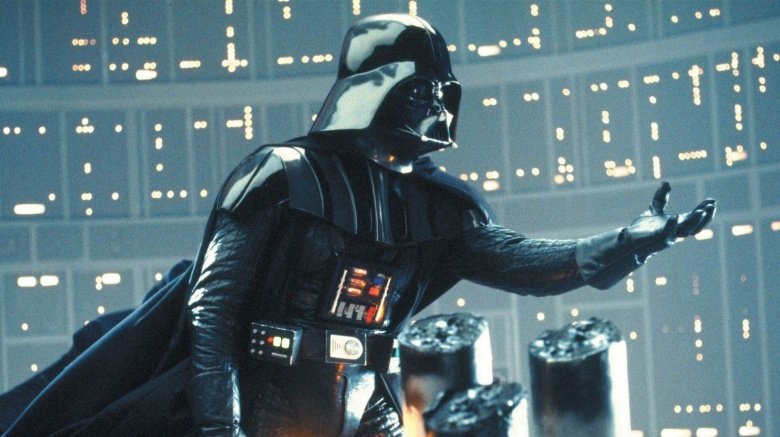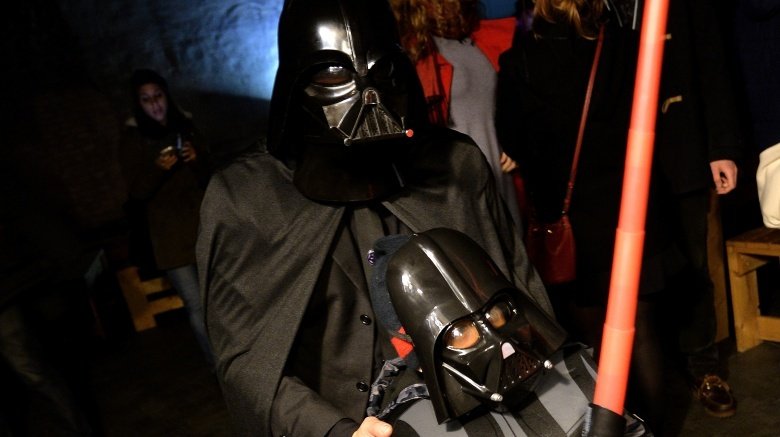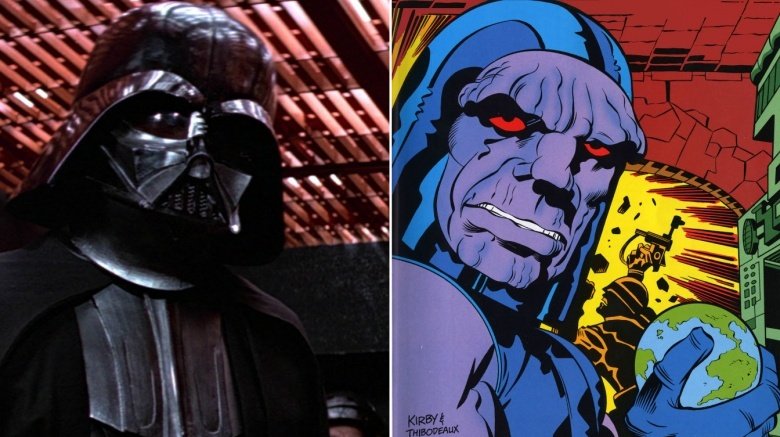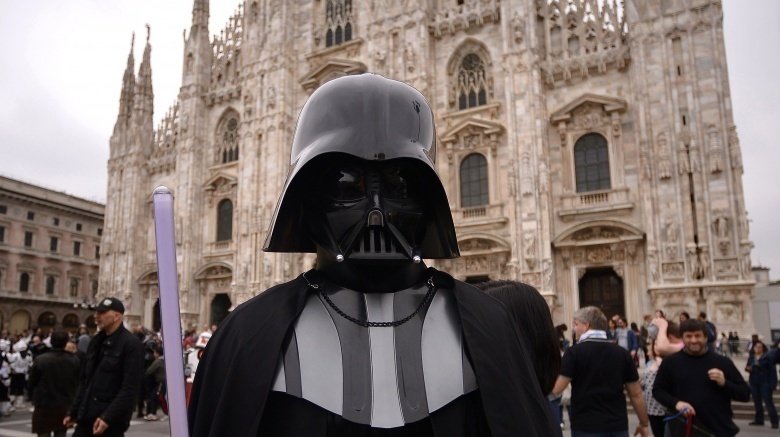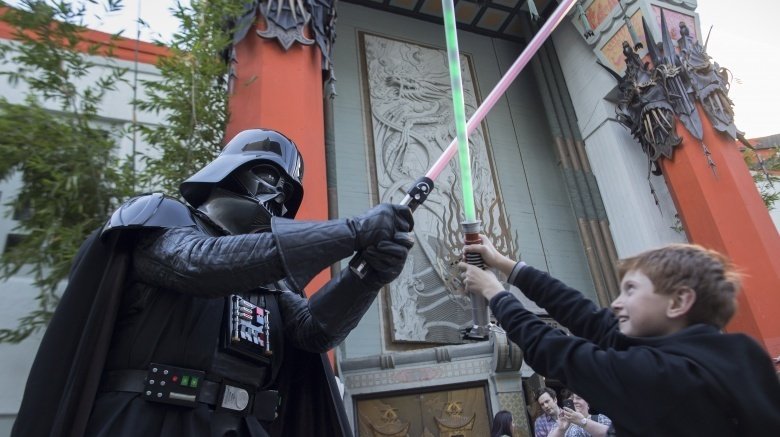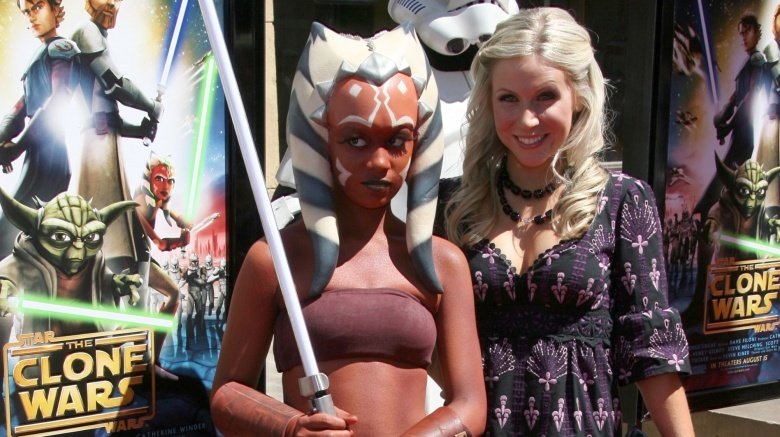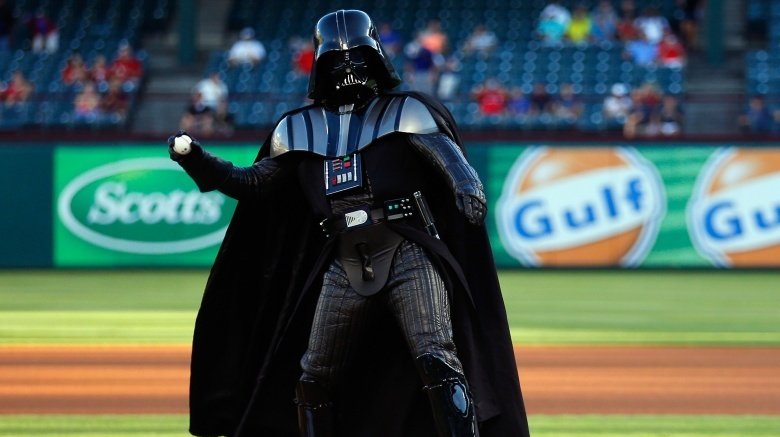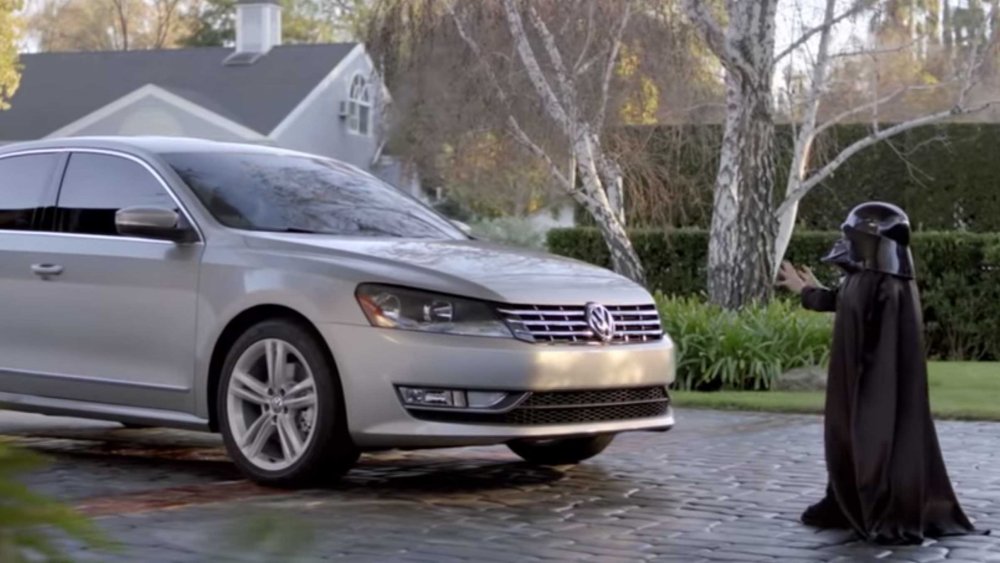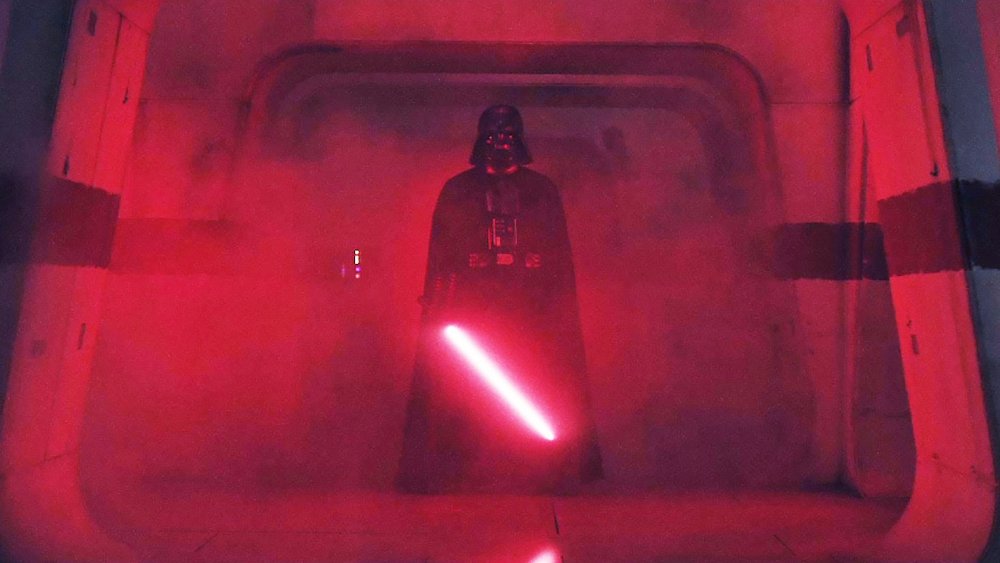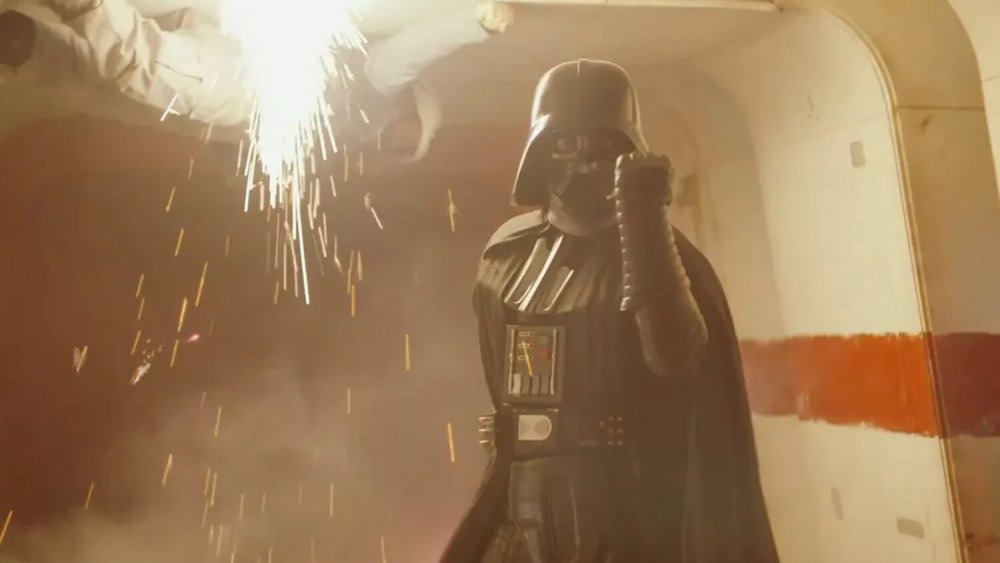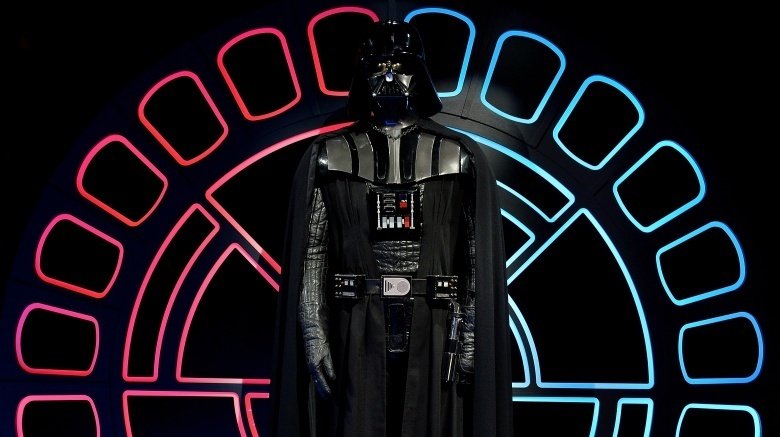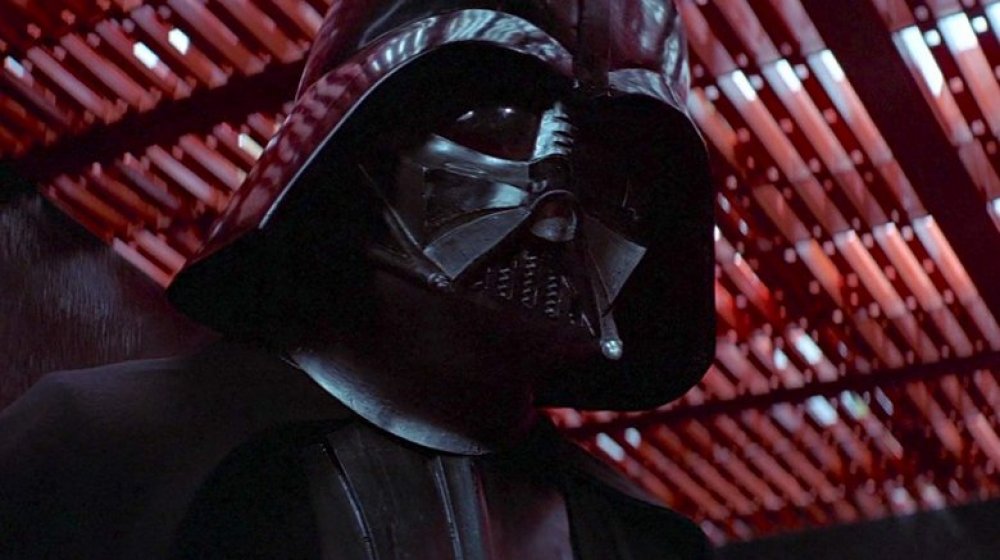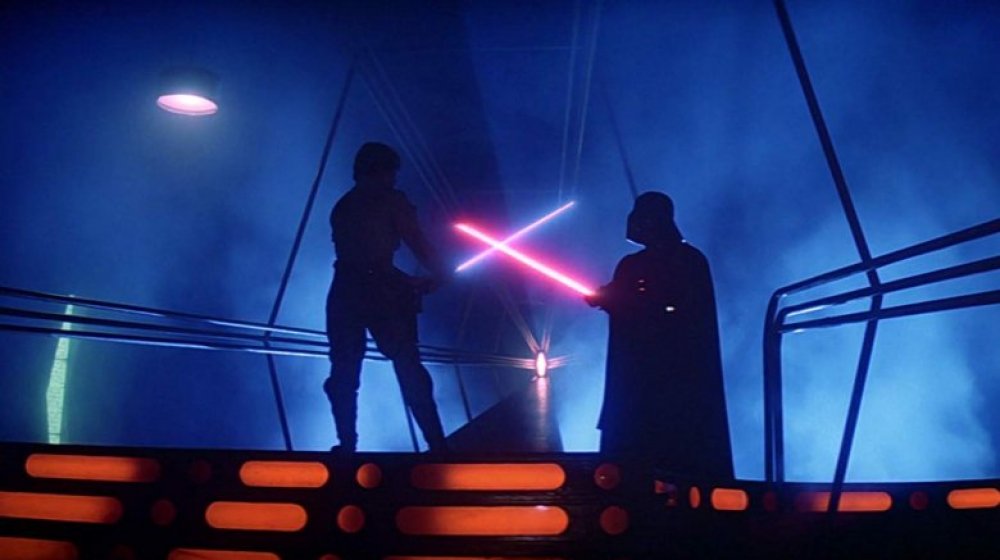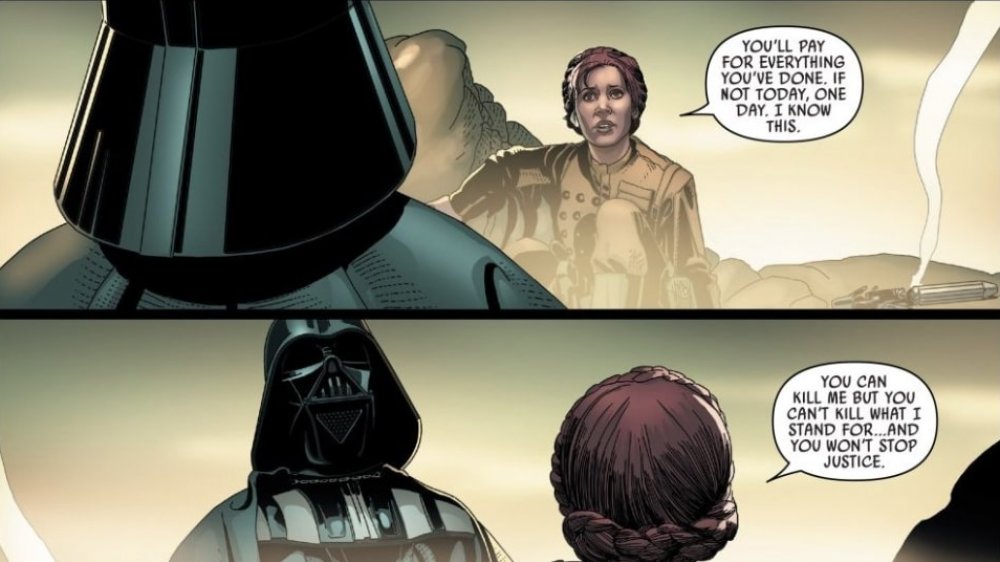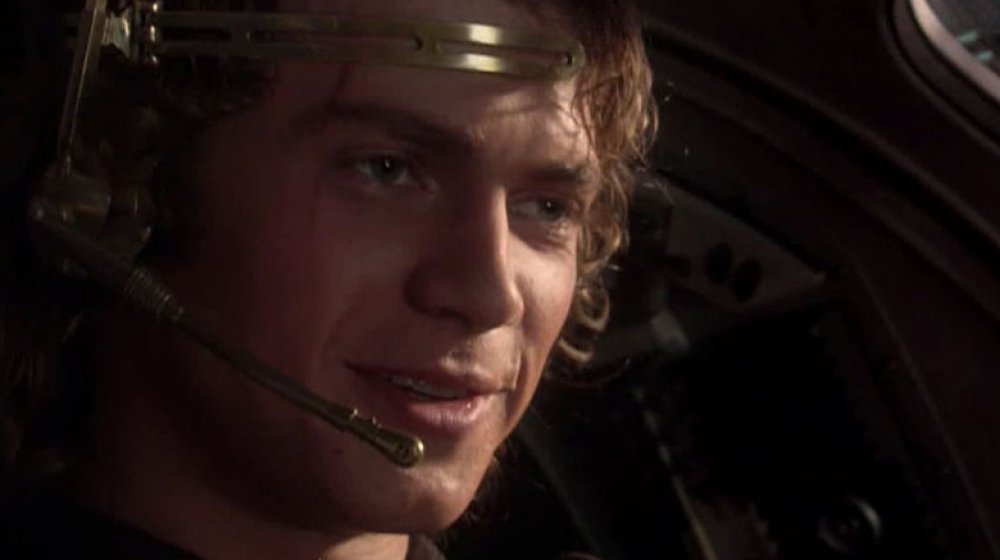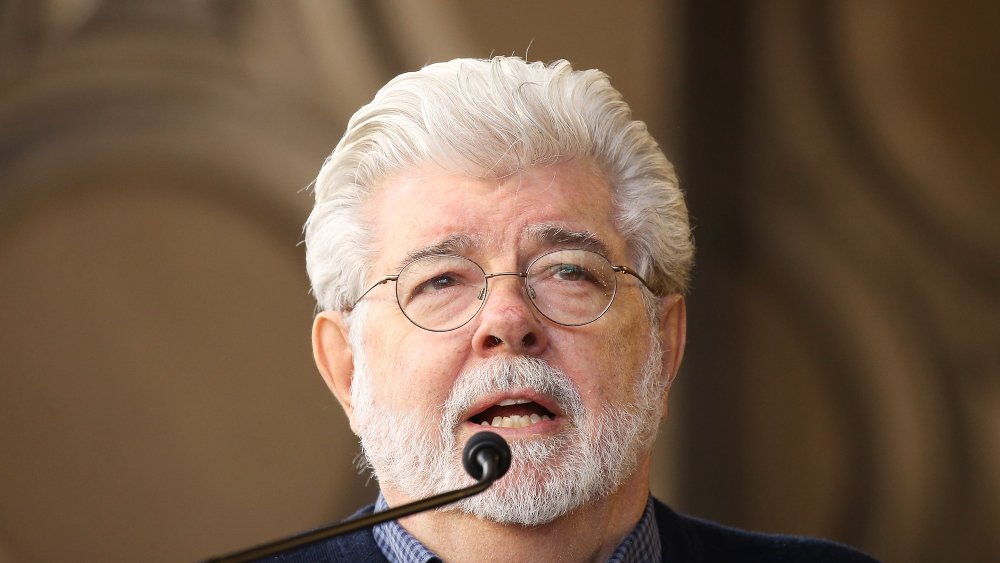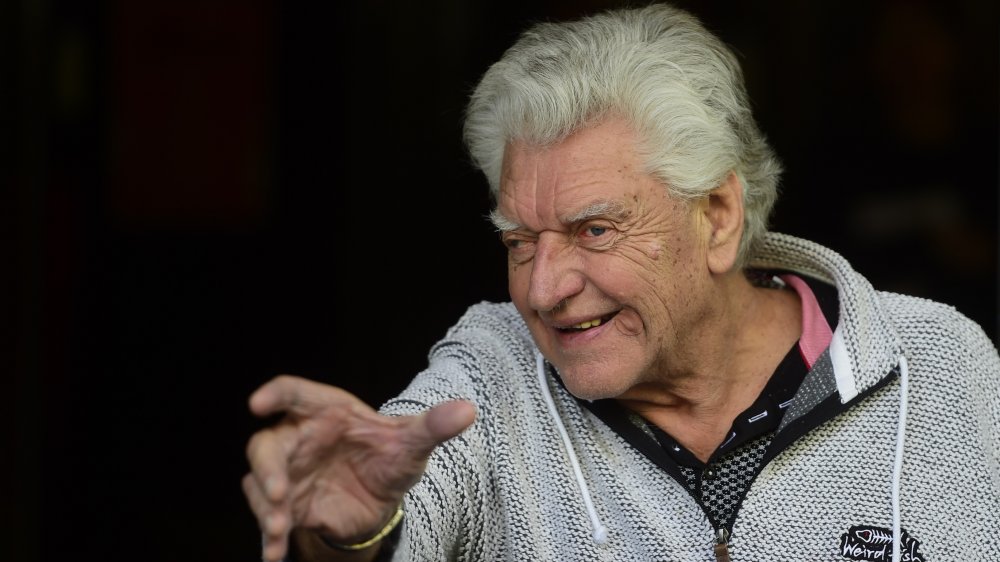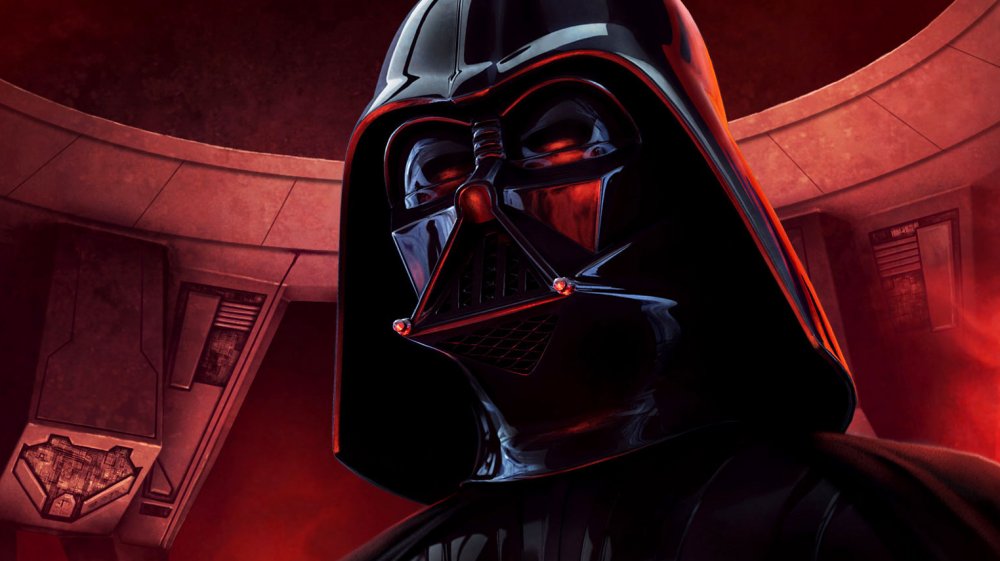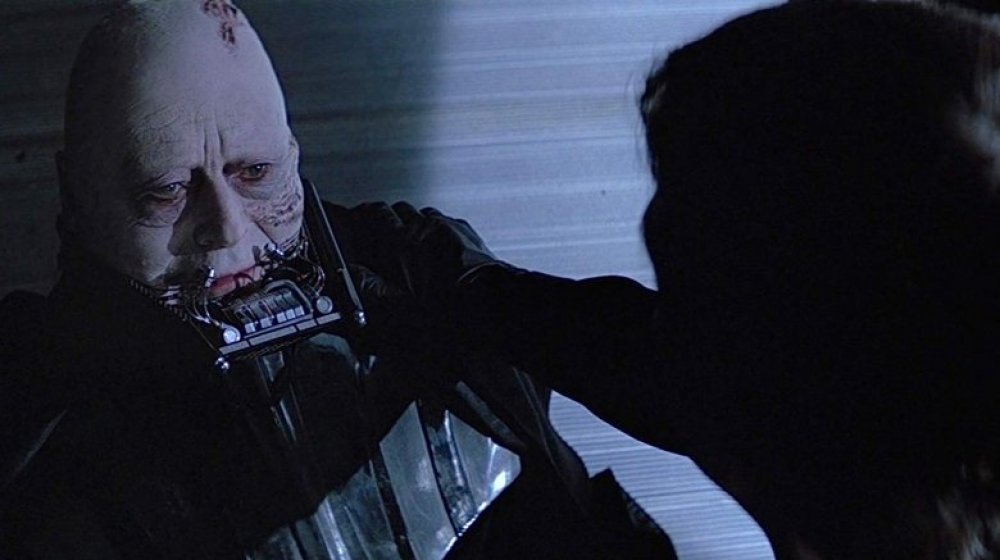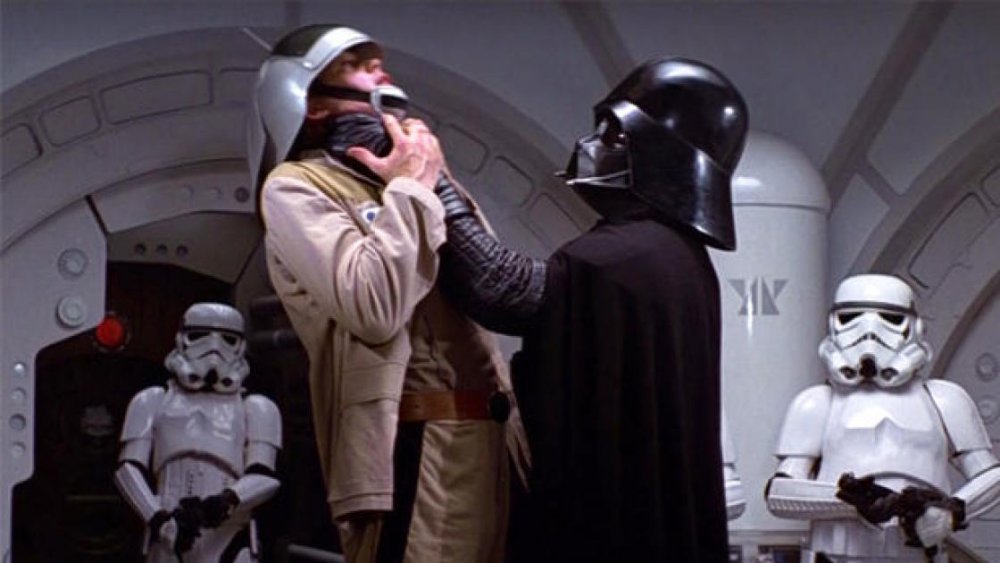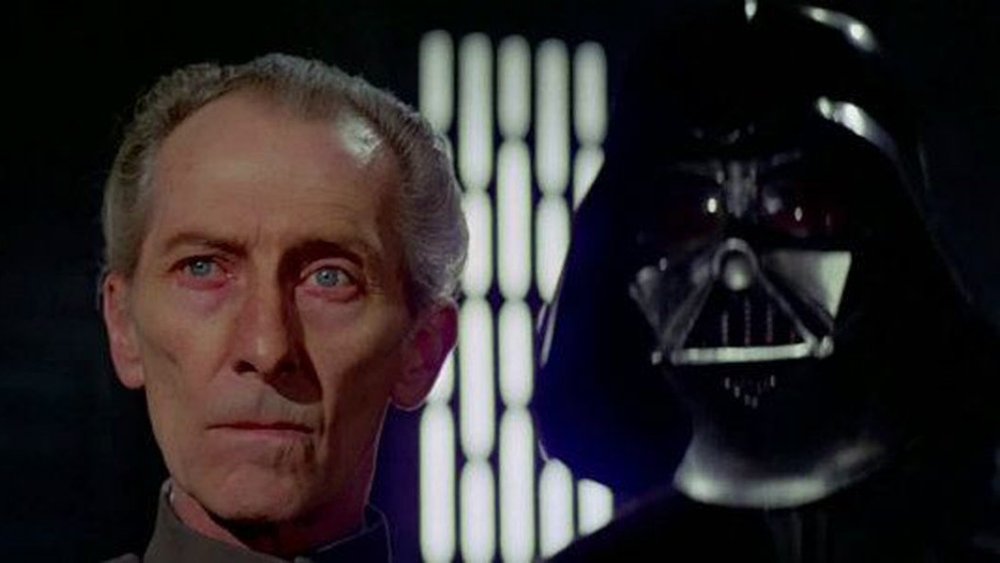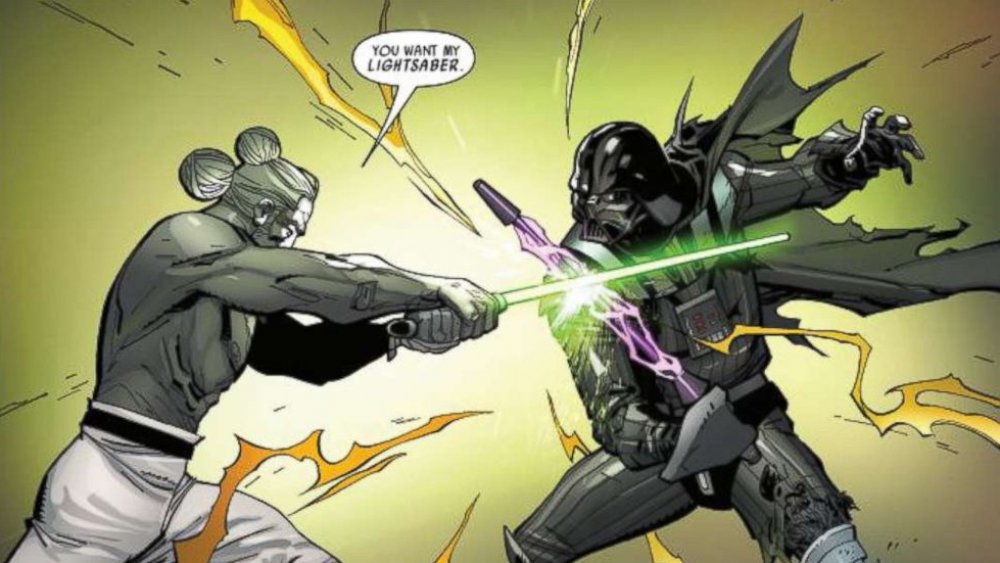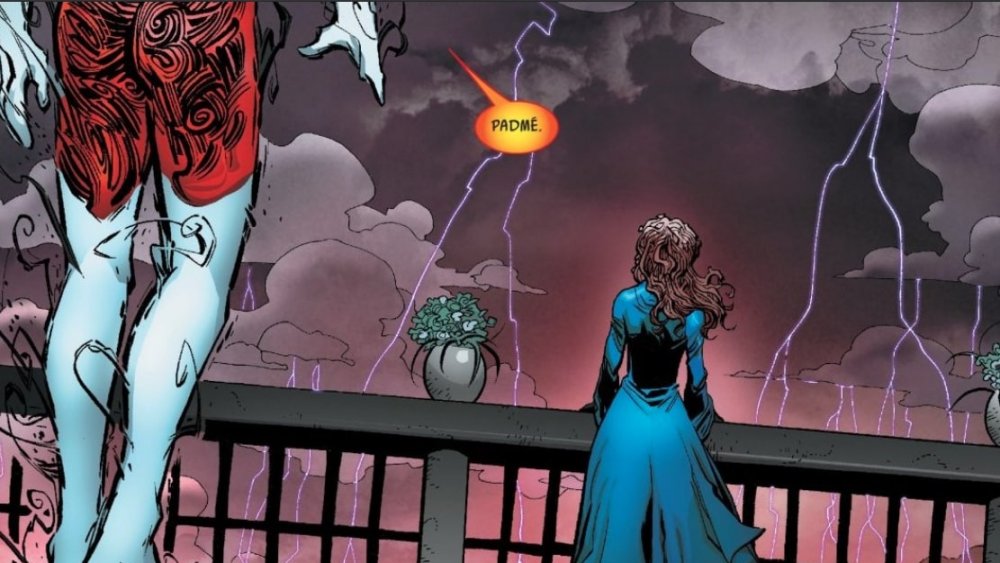The Untold Truth Of Darth Vader
A long time ago, in a galaxy far, far away, a legendary Sith Lord was born from the ashes of the defeated, disgraced young Anakin Skywalker. Darth Vader was — and is! — the most legendary villain in the Star Wars universe; there are few alive who don't know his name. But how well do you really know the onetime Jedi who became the Dark Side's most powerful asset? Here we have his untold story.
Darth Vader has been onscreen more than any other Star Wars character in history
When it comes to the most-revisited roles in Hollywood, Darth Vader is right up there with iconic characters like Batman in terms of providing work for actors. An awful lot of folks have done time under that big, black helmet, as the villainous Vader character has made official and unofficial appearances in more than 200 movies and TV episodes (including parodies and other properties), according to IMDb's count. To give you an idea of what a big deal Darth Vader is, consider that hero Han Solo only has around 100 screen credits to his name, according to IMDb.
Between the prequels, the spinoffs, the games, the animated series, the trilogy that started it all, and Vader's various crossover appearances in movies like Night at the Museum 2 and on shows like Robot Chicken, he's not just one of the most ubiquitous characters in Star Wars-related projects. He's one of the most recognizable pop culture figures on earth.
It took five men to bring the original Vader to life
The name most commonly associated with Darth Vader is James Earl Jones, who provided the menacing villain with his trademark baritone voice. But that's not Jones strutting around the Death Star in Vader's suit in A New Hope, or battling Luke on the bridge in The Empire Strikes Back — nor is that Jones' shriveled white head peeking out of body armor when Vader's mask finally comes off at the end of Return of the Jedi. Instead, a trio of men were responsible for creating Darth Vader's physical performance. Actor David Prowse wore the suit the most, playing Vader in a majority of his scenes, while fencer Bob Anderson stood in for the villain during his lightsaber battles. And Sebastian Shaw, a veteran stage actor, put on the helmet just once — in order to take it off again, in the scene where a dying Darth Vader is redeemed at last, in an emotional moment with his son.
And that's not all! Even after the contributions of one voice artist, two screen actors, and one stunt double, Darth Vader wouldn't have been Darth Vader without that freaky mouth-breathing effect — and for that, we can thank sound artist Ben Burtt, who created Vader's trademark panting with a microphone and a SCUBA tank regulator.
James Earl Jones didn't get credit for Vader's voice until Episode VI
Despite never appearing as Darth Vader onscreen, James Earl Jones will be forever remembered for the role — and he deserves the bulk of the credit for bringing the character to life. (Would Vader have been half as memorable without that voice?) But back in the day, Jones was the last to admit that his Darth Vader voice work was kind of a big deal. The actor declined to be credited on A New Hope or The Empire Strikes Back, explaining his thinking to PopMatters in 2008 (via io9).
Jones explained his reasoning, saying, "When Linda Blair did the girl in The Exorcist, they hired Mercedes McCambridge to do the voice of the devil coming out of her. And there was controversy as to whether Mercedes should get credit. I was one who thought no, she was just special effects."
"So when it came to Darth Vader," he continued, "I said, no I'm just special effects." He relented by the time Return of the Jedi rolled around, and his name finally hit the credits.
Orson Welles almost provided his voice
While James Earl Jones eventually fessed up to providing the voice of Darth Vader, there was a point in time where someone else was considered for the role instead: Orson Welles. In 2015, George Lucas revealed that he auditioned two people for the role, but once the tapes were in, the decision pretty much made itself.
"I knew the voice had to be very, very special," Lucas said. "And I had to make a choice — a choice that was a tough choice, but an easy choice, really — between Orson Welles and James Earl Jones ... [Jones] won hands down."
Good thing, too, considering Welles died in 1985, while Jones has been able to come back to voice Darth Vader again and again for years.
The original Vader suit design didn't include the iconic helmet
Can you imagine Darth Vader without his signature headgear? It almost happened. In George Lucas' original script, Vader's first appearance is described thusly:
The awesome, seven-foot-tall Dark Lord of the Sith makes his way into the blinding light of the main passageway. This is Darth Vader, right hand of the Emperor. His face is obscured by his flowing black robes and grotesque breath mask, which stands out next to the fascist white armored suits of the Imperial stormtroopers.
Note that there's no mention of a helmet in there; only Vader's respirator. Artist Ralph McQuarrie invented the signature headpiece, including the frightening mask with its grillework that suggested a set of skeletal teeth, when sketching the concept art for the first Star Wars film. Originally, the helmet was envisioned as an accessory that Vader would wear when traveling between ships in space, but something about it caught the imagination of the costume designer—and a masked, helmeted villain was born.
Vader's helmet is an amalgamation of military fashions from around the world
The headpiece worn by Darth Vader is most clearly a sleek riff on traditional samurai headgear, complete with the signature sloping neck protector known as a shikoro. But costume designer John Mollo wanted a variety of influences visible in Vader's look, and the final result is a pure blend. From behind, he's all samurai; from the front, the Sith Lord's helmet resembles Nazi headgear from World War II. And if you've ever seen a photo of a World War I soldier suited up for trench warfare, complete with gas mask, there's no question that Mollo took a cue or two from those designs when it came to marrying up the helmet with the faceplate.
He has his own castle
If you've seen Rogue One, you might have been surprised when the film suddenly took an unexpected detour into Mordor. But that wasn't Sauron's Tower of Barad-dûr, it was apparently Bast Castle, Darth Vader's secret getaway — sort of like an evil Fortress of Solitude. And this wasn't a weird bit of revisionist history; concept art for Bast Castle has been floating around since the late '70s, with Ralph McQuarrie's design originally slated to appear in Empire Strikes Back. One minor change: the location of Bast Castle has seemingly been moved from the acid rain planet of Vjun to the lava-drenched doomscape of Mustafar, where Anakin Skywalker had his legs lopped off by Obi-Wan Kenobi. We're guessing real estate prices were reasonable.
Darth Vader built the most pedantic droid in the galaxy
Before he succumbed to the power of the Dark Side (indeed, before he even knew there was a Dark Side), young Anakin Skywalker created the fussy, squeamish droid fans know as C-3PO. Unfortunately, he also simultaneously created one of the more irritating plot holes in the Star Wars universe: if Vader (née Anakin) made C-3PO, it's retroactively peculiar that he didn't recognize the droid when they ran into each other in the original trilogy.
However, that wasn't the end for Vader and his posh protocol droid. In the comic Star Wars #75, the Sith Lord found himself helping his old creation — but it wasn't out of the goodness of his heart. In a selfless effort to de-power a set of bombs in an earlier issue, C-3PO elected to face deactivation himself to save a planet and the rock creatures living there. Vader was injured in a scuffle, causing the Sith to retreat. When Darth used an energy blast to power back up, he unwittingly revived his old droid. Unraveling a slight Easter egg reference to his origins, the C-3PO says, "Thank the maker!" as Vader's blast breathed life back into him. If only he knew how right he was...
The man who played Darth Vader onscreen didn't know he was going to be dubbed
For most of the original Star Wars trilogy, the man behind the mask was David Prowse, a bodybuilder whose six-foot-five-inch build was perfect for creating Vader's imposing physical presence onscreen. But due to an unfortunate communication breakdown between Prowse and George Lucas, the actor reportedly didn't realize that his voice would be replaced by James Earl Jones' in post-production — and he wasn't happy when he learned the truth. Prowse was rumored to be difficult on set thereafter, refusing to learn lines for The Empire Strikes Back or Return of the Jedi, and his feud with George Lucas eventually reached the point where Prowse was no longer invited to participate in events with the rest of the cast. However, Prowse does deserve credit for his contributions to the series, particularly the climactic scene in which Darth Vader redeems himself to save Luke; the athletic actor needed only one take to pluck the Emperor off the ground and pitch him overboard.
Whatever feud may have existed between Prowse and Lucas, it was all water under the bridge by the time Prowse passed away in November 2020 at the age of 85. "David brought a physicality to Darth Vader that was essential for the character," Lucas said in a public statement. "He made Vader leap off the page and on to the big screen, with an imposing stature and movement performance to match the intensity and undercurrent of Vader's presence. David was up for anything and contributed to the success of what would become a memorable, tragic figure. May he rest in peace."
And dubbing Darth Vader was, sadly, very necessary
While David Prowse had the perfect build to play a physically imposing Sith Lord, his speaking voice — which was high-pitched and West Country-accented — didn't fit the bill at all. If you're wondering what Lord Vader would have sounded like as an Englishman, there are a few pre-dub scenes (like this one) still floating around that feature Prowse speaking Vader's lines. The result was so profoundly un-intimidating that Carrie Fisher, ever the cheeky one, started referring to Prowse on set as "Darth Farmer."
Darth Vader's true identity was an off-script secret
At this point, it'd be hard to find anyone who doesn't know Darth Vader is Luke Skywalker's dad. But when The Empire Strikes Back came out, Vader's famous revelation — "I am your father!" — was huge, earth-shattering, and one of the best-kept secrets in the history of cinema. Knowing that the real line was going to be overdubbed in post-production anyway, George Lucas put a big red herring in the script. When David Prowse read his line in the climactic scene, what he said (and what the crew heard) was "Obi-Wan killed your father."
But despite leaking the spoiler years earlier, even the guy inside the Darth Vader suit didn't know for sure that Vader was Luke's dear old dad until the movie hit theaters. The only person in the scene who actually knew the truth was Mark Hamill, who played Luke Skywalker, and even he was only told minutes beforehand so he could react with the appropriate level of anguish (which probably seemed pretty excessive to everyone else at the time).
The name is a clue. Or is it?
According to George Lucas, the name Darth Vader has a secret meaning. "'Darth' is a variation of dark. And 'Vader' is a variation of father. So it's basically Dark Father."
That seems like it might be a clue to the big secret that Vader would actually turn out to be Luke's dad. But skeptics have pointed out that the whole "Vader is Anakin" thing wasn't added to the storyline until well into the writing process for The Empire Strikes back, years after Vader was first named. So is Lucas full of it? Or did the name just turn out to be a happy coincidence? You be the judge.
Vader may have been swiped from Jack Kirby
Luke isn't the only member of the Skywalker family whose parentage may hold a shocking secret. In a case of art imitating life, it turns out that Darth Vader's real father might not be George Lucas at all, but rather legendary comic book creator Jack Kirby. According to the book Tales to Astonish, during a fateful dinner meeting in the early 1970s, Kirby told Lucas about a massive space opera he was planning called The New Gods, which features a helmeted villain named Darkseid facing off against a champion of light named Orion, who turns out to be Darkseid's own son and who struggles to overcome his family's legacy of evil.
Sound familiar? According to Ahmet Zappa of all people, Kirby was none too pleased with Stars Wars, feeling that Lucas had mined not just The New Gods, but all of Kirby's work for inspiration. "He told my dad stuff like, 'Darth Vader was Doctor Doom and the Force is the Source' and that George Lucas ripped him off." Well, you know what they say: if you're going to steal, steal from the best.
Vader is forever immortalized on the National Cathedral
You'll need binoculars to spot him, but he's there: Darth Vader's head is one of the grotesques (the Gothic stone carvings that deflect rainwater on old buildings) on the U.S. National Cathedral in Washington, D.C. In the 1980s, the Cathedral ran a contest through National Geographic World magazine inviting children to design grotesques to appear on the building's newly-constructed west towers. Back then, Darth Vader was the third-place entry; now he's the most popular part of the entire building. You can see the Vader grotesque high up on the northern-facing exterior, which is the dark side of the cathedral.
Darth Vader's fighting style is unique in the Star Wars universe
Compared with other Jedi — and even with his younger self — Darth Vader's two-handed lightsaber swordplay is distinctly brutal. As a young Jedi, Anakin Skywalker favored the same Form V lightsaber technique that Luke Skywalker would one day use against him. But once Anakin became Vader, he modified his Form V style to accommodate the limitations (and channel the full weight) of his life-supporting armor.
Vader had an apprentice
It may come as a surprise to learn that Darth Vader himself had an apprentice, given that the Sith supposedly follow a really stupid rule limiting them to only two members of a team at a time. Not to mention the fact that there has been no mention of any such apprentice in any of the live-action films. But there's a simple explanation: she was his apprentice before he became a bad guy. And also, she's from the cartoons.
Fans of Star Wars: The Clone Wars and Star Wars Rebels know, of course, that we're talking about Ahsoka Tano, who is one of the main characters in the cartoons. Nobody knows exactly what Ahsoka's final fate is, but considering she was thrown out of the Jedi order before the Purge, there's more to her story that fans have yet to see. The wait won't be very long, either: Rosario Dawson is set to play Anakin's former Padawan in season two of The Mandalorian.
Darth Vader's Imperial March is a ubiquitous presence on the playing field
John Williams' famous Star Wars theme might be one of the most iconic pieces of movie music in history (you can probably hear it in your head right now as you're reading this), but the piece of the Star Wars score you're most likely to hear in a sports stadium? That would be the fierce Imperial March, also known as Darth Vader's walking-around music. It's a staple of marching bands in college football games; in the NHL, the Montreal Canadiens use the March themselves to signal a powerplay; and elsewhere, it's often used to signal the arrival of the visiting team. The South Sydney Rabbitohs, Chicago Bulls, Los Angeles Clippers, Cleveland Cavaliers, and New York Yankees have all used the march to introduce their foes on the field.
Volkswagen loves Vader
The folks in charge of Volkswagen's memorable Super Bowl advertising machine have always appreciated the awesome power of the Dark Side. (Was the Death Star actually a feat of German engineering? DISCUSS.) In 2012, they stole the show with this commercial featuring a pint-sized Darth Vader and a Passat powered by the Force... or a remote car starter. And when it came time to tease their next Star Wars-themed ad, they did it with yet another nod to the greatest Sith Lord of all time, by getting a bunch of dogs to bark the Imperial March with perfect pitch.
Vader's big Rogue One moment was a last-minute addition
Although the Sith lord's appearance onscreen midway through Rogue One: A Star Wars Story was written into the script from the get-go, his most incredible scene came at the very end: an intense hallway battle sequence in which a besieged ship full of rebels raced to escape with their stolen blueprints for the Death Star while Darth Vader advanced on them, lightsaber in hand, cutting down every last man with casual brutality. It's an incredible moment, made that much more remarkable by the fact that it was tacked on at the last possible moment after the Rogue One editor argued Vader needed more screentime.
"We were cutting the film together and my editor, Jabez Olsson, he said, 'I think you need to see one last moment with Darth Vader,' like one more bad-ass moment with him," director Gareth Edwards explained. But the timeline was extraordinarily tight; said Edwards, "When he mentioned this, it was about four months maybe from release." Ultimately, the sequence was shot in three days—an incredible feat for a last-minute edit that ended up being among the best and most memorable scenes in the entire film.
Old Darth didn't learn any new tricks for Rogue One
Darth Vader was downright terrifying in Rogue One, which took place in the timeframe between Episode III: Revenge of the Sith and Episode IV: A New Hope and told the story of the first intrepid Rebels who uncovered the secret architectural weakness that would ultimately bring down the Death Star. But if you look closely at his deadly stroll down the hallway of a Rebel ship in the final moments of Rogue One, you'll realize that you've seen all of these moves before — and according to director Gareth Edwards, that was entirely on purpose.
"I think the golden rule was not to let Vader do anything that hadn't been seen or established in the original trilogy," Edwards explained. Hence, Vader was seen wielding a light saber and using the Force to choke the life out of some dudes — but not, for instance, breakdance fighting.
It's pretty crazy that he had only 12 minutes of screen time in the first film
That's right: Darth Vader, the fallen hero around whom the entire film franchise revolves, the most iconic villain in all of sci-fi, the Sith Lord whose rise and downfall will overshadow every Star Wars film ever made for the rest of time, was in the movie for a mere 12 minutes during his first outing onscreen. Even Chewbacca got more time in front of the camera than Vader in A New Hope. But those 12 minutes were all it took to leave a lasting impression, and create a villain whose legacy will outlive us all.
Vader's breathing is trademarked
In case anyone has the bright idea to profit off the instantly recognizable sound of Vader's breathing, beware: Disney can whip out some of those handy dandy cease and desist papers. As of 2009, Lucasfilm has officially trademarked the simple sound effect, expertly crafted using a scuba tank regulator, that has plagued nightmares since the '70s. The sound design team took Vader's already menacing appearance further with a noise that almost anyone can replicate on the fly. However, that replication comes with a pretty hefty price tag.
It's easy to mix up trademark and copyright definitions, but the differences aren't as subtle as people may think. Trademark is classified under consumer protection law (to help customers discern quality products), whereas copyright protects creators from other people reproducing or making money off their work. Trademark prohibits the use of a certain likeness, sound, or design for specific commercial use, but copyright is a blanket ban regardless of profits. Of course, the differences are far more nuanced, and copyrights don't have to be registered. But for the sake of anyone who doesn't have a law degree, we'll leave the specifics to the professionals.
Lucasfilm registered the breathing trademark under serial number 77419252, and the copyright prohibits the selling of items like toys, action figures, costumes, decorations, and games using Vader's breathing. If you're planning on selling a mask or action figure with Vader's stalker breath, prepare to pay handsomely — Disney's lawyers will find you.
No one remembers this line correctly
Darth Vader's franchise-altering "No, I am your father" line is one of the most misquoted moments in cinematic history. Countless fans misremember the quote as "Luke, I am your father." According to The Guardian, the site Lovefilm.com polled over 1,500 film buffs to determine which misquote rules the galaxy. Survey says? It's Vader's reveal.
Even James Earl Jones said the line incorrectly in the documentary Empire of Dreams: The Story of the Star Wars Trilogy. You know a misquote has reached peak performance when even the voice actor remembers it wrong.
Admittedly, the misquote raises the stakes and makes the sentiment even more personal and dramatic. Given the Skywalkers' flair for the dramatic, it's almost a bummer that the altered line isn't the canonical version. If you're randomly spewing the quote out of nowhere, the added "Luke" provides context, making it understandable that the misquote became so widespread. In fact, a lot of fans have heard the incorrect version before they've even seen the movie — making the actual reveal somewhat of a letdown. Thanks a lot, graphic tees, for improperly spoiling the biggest plot twist in movie history.
Leia battled Vader before Luke
Leia Organa was the first of the Skywalker twins to meet Darth Vader in A New Hope — so it's only fitting that she was the first to face him in battle, on the planet of Vrogas Vas.
In a fit of calculated vengeance, Leia ordered the Rebels to drop a fleet of Y-Wing bombs on the Emperor's lackey, who she still didn't know was her father, in the 2016 comic series Vader Down. The showdown took place between the aftermath of New Hope and the beginning of The Empire Strikes Back. While the films never adequately address Leia's gutting loss when Vader blows up Alderaan, here, she was willing to die to avenge her people — her family.
When Leia ordered the bombing, C-3PO said, "Oh, my, Princess Leia! That'll be certain death!" to which she responded, "It is. Hopefully for Vader, too." The grieving princess was willing to die not only for the Rebellion, but for Alderaan. Obviously, her attempt to enact justice failed, or the franchise would have been very short-lived.
Lucas lied about planning the Vader plot twist from the beginning
The implication that George Lucas lied about having major Star Wars details plotted out from the jump isn't exactly a secret. Between continuity discrepancies and early scripts popping up throughout the years, fans have debunked his declaration repeatedly. Seriously. What reasonably intelligent person wouldn't realize the relationship between himself and a new foe who shares the same last name? The galaxy isn't exactly crawling with Skywalkers.
Taking a step beyond speculation, an actual deleted scene from A New Hope sheds further doubt on Lucas' claim. In an extended version of the scene showing Luke's reunion with his old Tattooine buddy Biggs, Red Leader said, "I met your father once when I was just a boy. He was a great pilot. If you've got half the skill he had, you'll do all right." He didn't add any information regarding where he met Luke's father, so one could argue that it still works for continuity's sake: Red Leader could've met Anakin before he turned to the Dark Side.
Since few people knew that Anakin was Vader, those who remembered the former Jedi likely assumed that he was dead. Red Leader, being a reasonable person with a basic understanding of surnames, could have easily surmised the connection himself, though it's pretty hard to argue with the alleged script draft of The Empire Strikes Back that debuted Anakin's Force ghost while Vader was still alive and chilling.
David Prowse spilled the tea in an anti-George Lucas documentary
The drama between Lucasfilm and David Prowse extends even further than on-set shenanigans and his ban from official events. Prowse had a minor appearance in the documentary The People vs. George Lucas, which interviewed fans and people officially affiliated with Stars Wars to gripe about Lucas' failings.
In the section discussing the franchise's commercial sellout, Prowse said, "Return of the Jedi was the beginning... The merchandising raised its ugly head, and then the whole thing became super commercial from then onwards." According to The Daily Beast, Prowse didn't even know the purpose of the documentary. It's entirely plausible that the filmmakers didn't give any background on the project, as they appear to have interviewed him on the fly in the middle of an autograph line. The film cuts out any prelude to Prowse's answer, making it possible that the interviewer insinuated the desired response within the question without much context. He didn't actually throw shade at Lucas himself.
According to Comicbook.com, Mark Hamill almost suffered the same fate. "I almost got hornswoggled into that documentary," he said. "They weren't calling it The People vs. George Lucas at the time. But I could tell from the questions they were asking me that it was an open invitation to trash George." It's pretty shady to manipulate interviews to serve your own purpose, and poor Prowse can't seem to catch a break.
But secret or not, Prowse spoiled the biggest plot twist in cinematic history
David Prowse appeared at a fan event in Berkeley, California two years before the "I am your father" plot twist unfurled in The Empire Strikes Back. The actor proposed a possible scene where Luke finds out that Vader is daddy dearest during a lightsaber battle. A newspaper printed the spoiler in what appears to have been autumn of 1978 — the same year that Lucas wrote two drafts of Empire. The newspaper clipping in question was titled, "May the sequel be with you." Contained in the article are quotes from Prowse, including his statement that "Father can't kill son, son can't kill father." He elaborated, "So they live again to star in Star Wars IV." The crowd apparently met the statement with enthusiastic applause.
Lucas was initially dissatisfied with much of the original Leigh Brackett draft, completed in February of 1978 — notably after Prowse's Berkely event. Some of his concerns included the appearance of Anakin's ghost. Fans have argued that Anakin did technically die when he became Vader, making it plausible that Anakin's ghost and Vader could hang out in the same timeline at once. It's not implausible, though, that the Vader plot twist happened after Prowse announced it. Prowse noted in the 2015 documentary I Am Your Father that the announcement was just "a good guess." Is it possible that Prowse inspired the iconic plot twist with his off-the-cuff theory?
Lucasfilm blamed Prowse for leaking Vader's death (he didn't)
Return of the Jedi producer Howard Kazanjian claims that only three completed scripts of the film ever existed. They belonged to Lucas, Kazanjian, and director Richard Marquand. According to Den of Geek, Kazanjian said about Prowse, "For delicate information lines, he would simply count one, two, three, four, or read a fictitious line in character to the real dialogue." That didn't save Prowse from paying the price for leaking Vader's death to a tabloid.
Prowse told The Void that a reporter contacted him at the gym to set up an interview about his weightlifting career — but the journalist turned the tables on the actor, telling him that Vader was getting killed off. The reporter also claimed that another actor would appear behind the mask. When Prowse looked at his call sheet, it read: 'Dave Prowse, Darth Vader, Studio 1' and 'Sebastian Shaw, Anakin Skywalker, Studio 10'.
Just one day after the interview, The Daily Mail published an article titled "Darth Vader to be killed off in the next movie, in an exclusive interview with Dave Prowse." Decades later, I Am Your Father set the record straight, getting the journalist to admit that Prowse didn't spoil anything, and the leak came from another source. The massive spoiler was the final straw for Lucasfilm, who significantly cut Prowse from filming scenes. His stuntman Bob Anderson mostly donned the Vader armor in Return of the Jedi, nearly replacing the original actor.
David Prowse wasn't behind Darth Vader's mask
The final betrayal for Prowse came in the form of Vader's helmet reveal. When he told Luke, "Let me look on you with my own eyes," Prowse's eyes weren't actually the ones staring back. Actor Sebastian Shaw scored the small scene — a slap in the face to Prowse, who was under the impression that he would be unmasked at some point during the series.
In the documentary I Am Your Father, Prowse pulled out an on-set photo of him as unmasked Vader that he autographed for himself in jest. He read out his signed inscription: "Now I know why Sebastian Shaw got the role. I was too handsome for the..." Prowse's laughing masked the end of the quote, so despite the drama, he seems to be in relatively good (yet salty) spirits about the whole ordeal. The interviewer agreed that Prowse should have been unmasked. Prowse responded with, "Yeah, it should have been. Yeah, definitely. Yeah, yeah."
To make matters worse, Prowse told Equity Magazine that he still hasn't received residual payments from Return of the Jedi because it "hasn't made a profit" and added, "If there's a pot of gold somewhere that I ought to be having a share of, I would like to see it." Despite the drama, Prowse still has a positive outlook on his Star Wars experience. "Well, I'm grateful for everything that's happened to me from Star Wars," he told The Void. "It altered my career completely."
Vader's armor caused excruciating pain
Angsty Anakin Skywalker is known for his rollercoaster of emotional pain, but while trauma was the young Jedi's motivation, pure torture was Vader's cross to bear — and most of it came from his armor. Underneath his sleek cyber suit were several layers of rotting flesh that never healed after his fateful lava bath on Mustafar.
The nerve damage was immense, and he had to take numbing agents and sanitation baths on the regular. No more cantina visits for Vader, either: He was doomed to ingest food paste through feeding straws. There's also the small fact that his helmet bolted to his head and continually stabbed him with needles to keep his mind synced with the suit. Basically, not a second of Vader's life went by without searing pain. His constant torture allowed him to drown in his anger, becoming a stronger Sith Lord every day.
It's safe to say that a man as ruthless as Vader had a stock of enemies even within his ranks — as he's perfectly cool with Force-choking his own men. Anyone could easily kill him in his pathetic suitless state, proving how feared he is by power and presence because no one ever does.
Tarkin knew Vader's identity
People have debated whether or not Grand Moff Tarkin knew Vader's former identity as Anakin Skywalker for decades. Clone Wars showed Anakin fighting alongside Tarkin — where he witnessed his fighting style and relationship with the Force, forging a history between the two before either became entangled with the Empire. The canonized novel Tarkin takes the theory a step further as the Empire goon mulls over the similarities between Anakin and Vader.
"Vader may very well be Jedi Knight Anakin Skywalker," Tarkin tells himself at one point. Later in the novel, Palpatine queries whether Tarkin knows the secret, and uses it to test his follower's loyalty. The regional governor could have done anything with this information, but chooses to keep silent. Tarkin becomes the only character to show respect and dedication to Anakin and Vader despite his skepticism of the Force. (Palpatine doesn't count, since he uses Vader as a plaything for his own gain.)
Darth stole his Sith saber
While tradition tasks Jedis with crafting their own lightsabers, the Sith have a much darker ritual. To create a daunting red lightsaber, Sith Lords go all klepto on their Jedi counterparts. They have to steal a Jedi's Kyber crystal, warping the once-benign object with rage, fear, and loss — the buzzwords of the Sith. The Darth Vader comics reveal that Vader stole his crystal and hilt from a Jedi known as Kirak Infil'a.
His original iteration of the weapon, as shown in the comics, isn't what fans have come to associate with Vader. After using the Jedi's stolen hilt for a while, he eventually crafted one that matches up much better with his tech-driven armor. The lucky (or unlucky, depending on your point of view) change in the weapon's aesthetic wasn't by choice: Bounty hunters almost destroyed Vader's stolen saber during an attempt on his life.
Palpatine explained the process to his apprentice by assuring him that there isn't a difference between the blades of the Jedi and Sith — except that the Sith weapon, as he ominously put it, "has been made to bleed."
Vader built his castle to resurrect his dead wife
Everyone's built a dreary castle to resurrect their dead loved ones... right? Choosing to build his castle on Mustafar, the site of his wife's demise, was less about marking Vader's birthplace and more about lamenting Padmé. Even though he went Dark Side while attempting to save her, it seemed he'd all but forgotten his wife after the infamous "Nooooooooo!" he exclaimed at the end of Revenge of the Sith.
In Darth Vader #22-25, Vader began building the first version of his castle with the help of Sith artist Lord Momin's helmet, a gift from Palpatine. In true Hamlet fashion, he used the helmet, which still held Momin's spirit, to craft multiple iterations of his castle. After a battle with the locals and a betrayal from Momin (who used his creation to bring his own body back from the dead), Vader re-killed his betrayer. Darth finally succeeded in his mission to cross the veil between life and death, departing from his body and going on a Force journey.
Vader's spirit melded between his life as Anakin, his current state as Vader, and even received fuzzy snippets from the future. He finally reached Padmé, either in spirit form or how Vader remembered her, but she immediately rejected him. She insisted that Anakin died and she didn't know the man standing before her. Padmé then plummeted into an abyss of fire, and Vader was finally forced to let her go — which was clearly Palpatine's plan all along.
